TAG | LED downlights
Megaman, a leading LED lighting solution provider, is proud to announce the launch of a new selection of GU10 lamps.

Megaman, a leading LED lighting solution provider, is proud to announce the launch of a new selection of GU10 lamps that incorporate the company’s new Hybrid Reflector and U-DIM™ technology.
A new 4W (250lm) GU10 and 5W (360lm) dimming GU10, with 25,000 hours’ life, are now available in Megaman’s popular Economy range, whilst the Professional range sees the addition of a new 5.5W (500lm) and 7W (550lm) dimming GU10, both with 50,000 hours life.
All of the new dimming GU10’s incorporate Megaman’s revolutionary U-DIM™ technology as standard – making the lamps compatible with a wider possible range of existing dimmers, whether they are leading-edge or trailing-edge.
The new 7W addition to the Professional Range also features Megaman’s new Hybrid Reflector, providing excellent optics, high efficiency and precise beam control.
Megaman’s Economy range comes with 2 years warranty and the Professional range with 3 years as standard, extendable to 5 years through the website.
Buy Megaman GU10s from our website: www.novelenergylighting.com, or call us to discuss volume requirements: 0208-540-8287, email: sales@novelenergylighting.com
LED downlights · led GU10 · LED lamps · led spot · megaman 5.5w gu10 · megaman 5w gu10 · megaman 7w gu10 · megaman gu10 · Megaman LED · Megaman LED GU10 · u-dim
A new survey of hospitality professionals has found that lighting is an integral part of the package when it comes to encouraging guests to stay longer and make repeat visits to a restaurant, hotel or bar.
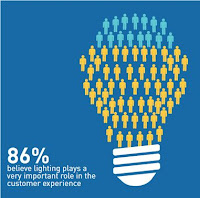
86% of hospitality professionals believe lighting plays a very important role in the customer experience. The findings of the survey, sponsored by Megaman, reveal that lighting is big business in the hospitality sector:
- only 1% of those surveyed think lighting is of no importance in the customer experience.
The findings show that good lighting encourages guests to stay longer and come back for more:
- 72% have left a venue earlier than planned because it was too brightly- or poorly-lit
- 74% have stayed longer than planned because the lighting made them feel relaxed and welcome.
Respondents thought a well-lit venue is:
- “somewhere that draws you in” (36% of respondents)
- “somewhere to spend time” (34%)
- “somewhere to go back to” (26%)
- none of the above (4%).
The survey revealed that respondents thought that upfront lighting refurbishment costs are less important than ambience. When making decisions on new lighting in a venue, hospitality professionals say that key considerations are:
- the effect and ambience of the new lighting (67%)
- the ability of staff to dim the lights (43%)
- energy bill/CO2 savings (31%)
- the upfront costs (23%).
Overall, 43% of those surveyed have been involved in a lighting refurbishment in their present or previous venue and said:
- the new lighting had been well received by customers – 84% of customers gave positive feedback on the lighting refurbishment
- good lighting boosts business – 91% think the lighting refurbishment had a positive impact on business in terms of an uplift in sales or profits
- education is still needed about the benefits of LEDs.
Only half of all hospitality professionals (49%) think a halogen lamp ban next year would be a positive change for them, while 36% say it would not affect them at all and 15% think that a ban will have a negative impact on them.
Fred Bass, managing director of Neonlite International, the brand owner of Megaman, said: “This survey supports what we are seeing in our day-to-day business within the hospitality sector – good quality lighting is appreciated and a well-lit scheme attracts customers who stay longer and spend more.
“However, the one area where I think we are at the cusp of a tipping point is in the understanding of the benefits of LEDs amongst the majority of those in the hospitality sector. Although half of those surveyed say that they think the banning of halogen lights and introduction of LED equivalents would be positive, there is still another half who are unsure.
“As more and more bars, restaurants and hotels experience the benefits of the latest in LED lighting technology, I believe we will see a dramatic sea-change in favour of LEDs.”
hopsitality led · hospitality lighting · led ambient lighting · LED downlights · led gu10s · LED lamps · LED spots · Megaman LED · Novel Energy Lighting

Sainsbury’s is one of a number of companies to bid for an Electricity Demand Reduction grant, as Whitehall eyes ways to keep the lights on in winter.
The Government is investing nearly £5 million to encourage leading UK firms such as Sainsbury’s, to install energy efficient lighting.
The money is part of an attempt by Whitehall to reduce peak time energy levels as fears rise that the National Grid will not be able to cope with electricity demands this winter, leading to nationwide blackouts.
A string of leading companies, including British Gas, Sainsbury’s, Sony and BAE Systems, have bid for funding in the second auction of the Electricity Demand Reduction (EDR) pilot.
Plumbing firm Wolseley UK received an EDR grant of £100k and is using the money to kit out its distribution centre with upgraded LED lighting.
The company claims that the new fixtures will reduce its electricity demand by 236,000 kWh, which is enough energy to power more than 300 homes.
Wolseley worked closely with Cloudfm on the maintenance work, a partnership that has also led to Wolseley’s head office in Leamington Spa being awarded a BREEAM “Excellent” rating.
The scheme works by encouraging consumers to provide capacity in the form of megawatts to help the UK meet its energy efficiency targets and reduce pressure on the National Grid. The pilot also reduces the energy bills of those involved.
The Government had originally allotted £6 million to the pilot, but a lack of uptake meant that not all the money was allocated.
This is the second time that an EDR auction has failed to reach its target, the first, held last year, saw only £1.28m out of a total of £10 million being snapped up.
edr · electricity demand reduction · energy reduction · LED downlights · LED lamps · led lighting · led panels · LED retrofit · led tubes · Novel Energy Lighting
image: The Midnight Sun, Anda Berczky, 2005
Here’s a quick check list for your tunable-white specifications.* First, do you actually need a tunable white system? What colour temperature range do you need for your project? Does your preferred product maintain a consistently high level of colour rendition throughout its range? Do you have a control strategy for the changes in colour temperature and output? Does the product interface with the control strategy for what you want to achieve?
Tunable-white lighting is one of the biggest trends in commercial lighting. LED developers have taken a serious grip on the photo-biological research being produced by university departments and other groups. We know more about the way that humans function than ever before and you might say that it’s fortunate for the LED community that the science appears to support a practical technology that is perfectly suited to LED exploitation.
Tunable whites use colour mixing
Standard LED colour-mixing uses red, green and blue channels that are adjusted to deliver the entire range of the colour spectrum. Tunable-whites work in the similar way, using of a number of controllable channels to adjust the colour temperature of the luminaire’s white light output. The channels in a tunable-white system all produce white light, but with varying colour temperatures, from a warm tone to a cool tone.
Inevitably, there are levels of sophistication involved in tunable-white systems and it’s vital that the specifier understands not only what is required from the lighting, but also what any particular system is capable of delivering.
Simple systems use two lines of LEDs
Take a warm white LED and sit it next to a cool white LED and cross-dim between the two. Job done? Well, not quite. It’s true that the cheapest tunable whites work in exactly this way. The most basic tunable linear systems use LED strips mounted side-by-side. One channel will be close to 2700K in colour temperature, with the other up around a cool 6000K. The LED strips are mounted inside an aluminium extrusion fitted with an opal diffuser, which does the colour mixing as the light passes through it. It’s very simple engineering but satisfies a basic market with low performance expectations.
Multi-chip versions do the mixing at chip level
More products are using ‘multi-chips’ where a number of tiny LED chips are combined into the same module. This means that the colour mixing occurs as the light leaves the module. Their very small size means that tunable-white products can be made much smaller, so we’re starting to see downlights using the technology as well as linear systems. These multi-chips tend to have a higher performance specification than the individual LED strips, but nothing should be left to chance.
Colour rendering can be compromised
A lot of fuss is made, quite rightly, over the way that white light presents surface colours. We’ve come to expect a good quality of colour rendering, regardless of light source. Tunable whites are not exempt from this issue but it’s not always clear from manufacturers’ data how well a system is performing.
Cheaper products may advertise good colour performance at the extremes of the tunable range, where light is being delivered from either the warm or the cool channel, but there’s no certainty that the mixed light performs equally well. Generally speaking, the greater the number of channels, and systems vary from two-channel to five-channel, the better colours will look under them.
Not all tunable-white systems cover the same colour range
If there is one aspect of tunable-whites that the specifier needs to take great care over, it’s the colour temperature range that’s on offer. While some systems offer a wide natural ‘circadian rhythm’ range that shifts from candlelight to daylight, there are other systems with a much smaller range, from 2500K to 4000K, which should only be considered as a decorative option.
There are three ways to control the tones
- The simplest systems use manual control to alter the white outputs. Expect to see a wall-mounted control panel or a hand-held remote control that enables you to adjust the colour of the light and the amount of light output. There is nothing scientific about this. It’s left entirely to personal preference, which may – or may not – be a good thing.
- Some tunable controls are designed to replicate the effect of dimming on a filament source, where two things happen at the same time. As the light output is dimmed, the lamp warms up in the same way as a traditional tungsten filament lamp. This is still a manual control method, but has the benefit of mimicking a filament light source. The tunable range tends to be very small, again mimicking the conventional tungsten lamp.
- More sophisticated control strategies are designed to manipulate the circadian rhythm of room occupants. This means that the lighting settings are programmed into the control architecture. Shifts in colour temperature and light level can be pre-set or can be instigated by a manual over-ride. This is the method that’s being used in recent school installations in Scandinavia.
Three discrete channels could be a solution
It’s been pointed out that not all ‘tunable-white’ mixing requires a full colour range. Complex tunable-white schemes mean that you should be able to call up any colour temperature within the mixing range. But some clients will call for specific colour temperatures, often those that are commercially available, such as 3000K, 4000K, 6500K. If that’s the case, then it may be simpler – and cheaper – to consider having three discrete lighting channels operating separately within a bespoke housing.
Photo credit: Glamox Luxo
colour temperature · LED downlights · led lighting · led panels · Novel Energy Lighting · school lighting · tunable light · tunable wite light

Megaman has supplied its Siena 20.5W to The Danielle Brown Sports Centre at Leicester University for a £75,000 gym refurbishment. The Sports Centre, named after Danielle Brown MBE who studied law at the university and holds ten Paralympic world records, features a 20m pool, sauna and steam room, as well as cardiovascular gym and a double size sports hall.
Megaman’s Siena high performance, integrated LED recessed downlights have been installed in the gym to replace the 36W CFL and 50W downlights previously providing the illumination. Compact in size and with no external driver, the Siena range is easy to install and maintain and delivers a high efficiency lumen output which, in turn, produces more light when compared to conventional plug-in, tube downlights. The Siena range of fixtures offers 50,000 hours life and instant start-up. Siena is also IP44 rated, making the fitting suitable for humid and damp conditions.
The lighting revamp has resulted in savings of 2862.77 pa in CO2 and a payback of £665.76 annually with final payback in 2.3 years. Everyone, users and staff alike, agree that the gym has been transformed into a much brighter place to exercise. The refurbishment has been finished off with all existing machines being upgraded to the latest specification, which includes screens on machines so you are able to watch live TV whilst completing a workout.
Visit www.novelenergylighting.com today to explore our Megaman LED retrofit solutions, or call: 0208-540-8287, email: sales@novelenergylighting.com
danielle brown sports centre · LED downlights · LED spots · megaman downlights · Megaman LED · megaman siena · Novel Energy Lighting
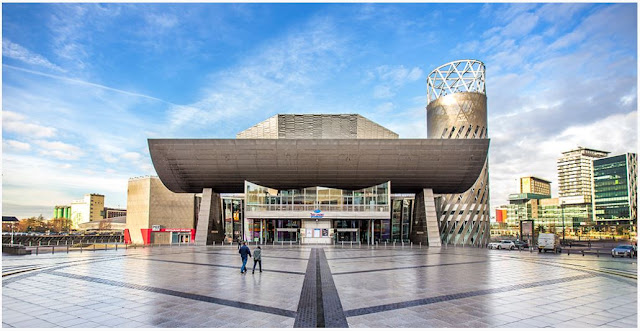
State-of-the-art LED lighting brings new life to The Lowry’s high-profile auditoriums. The major upgrade shows Dextra Lighting’s edge over competitors by offering the theatre venue both quality and modern functionality, without compromising on affordability.
About the Project
The Lowry is the fruit of decades of continuous efforts to regenerate the local docklands. The magnificent architectural landmark is more than just an arts centre, it is a bustling tourist destination, attracting hundreds of thousands of visitors every year to the Greater Manchester region. Since opening in April 2000, the flagship building has been raising the cultural profile of the North West and boosting the regional economy. The centre now offers a number of facilities including two high-profile theatre halls – the Lyric, with a capacity of 1,730 and the Quays theatre, offering up to 430 seats.
The complex is situated in the heart of Salford’s thriving MediaCityUK; a creative hub for the digital and media industries. In 2007, the BBC relocated five of its major departments from London and its existing Manchester offices to the redeveloped Salford Quays, using The Lowry’s theatres and studio spaces for a number of productions and events.
Launched as a National Millennium project, The Lowry has been financed through British and European public sector programmes and patrons from the private sector. As a cultural attraction of national and regional importance, the project’s procurement and design process have always been to the highest standards, with periodic renovations aimed at improving the financial and environmental sustainability of the building. With this in mind, Dextra Lighting were approached by AA Projects’ experienced team of low carbon consultants, to provide a modern lighting solution balancing quality with cost-effectiveness, using its vast range of precision-engineered LED luminaires to enhance the theatre’s facilities.

The brief
The lighting upgrade targeted both the main auditoriums and backstage areas. The theatre’s existing lighting needed to be replaced with cutting-edge LED alternatives, offering today’s standards of energy-efficiency and flexible controls, whilst creating a suggestive atmosphere for theatre-goers. For the back-of-house areas, energy-saving, low-maintenance lighting was required abiding by all health and safety regulations. Dimmable front-of-house lighting was required to allow The Lowry’s technicians to easily and accurately dim the lights from the audio-visual control rooms. Overall, the LED upgrade’s aim was to save The Lowry more money on the installation through reducing electrical consumption, installation and maintenance costs.”Pro-light Mini – The Lowry saved money on installation with this product, as prewired leads and simple retractive spring clips helped minimise fitting times”
The products
Theatre Main Lighting – Protec LED
The highly popular Protec LED downlight was supplied in a range of lumen outputs to act as primary lighting for both the theatre halls. Using the latest Lumileds LEDs and efficient anodised aluminium reflectors, the luminaire offers impressive energy savings with short payback periods over fluorescent equivalents. The combination of high-quality LED sources and advanced optics allow the Protec LED to offer LORs in excess of 90% in lumen outputs of up to 3000lm to allow The Lowry to comfortably meet its energy targets whilst giving designers the flexibility to tailor the installations to suit the hall’s architectural design.
The Protec LED’s appealing contemporary construction is ideal for high-end specifications and can be customised with a wide selection of options including,
interchangeable reflectors and colour attachments, and custom bezels (for retrofit applications), to suit a host of interiors and adapt to future changes in decor.
From a range of dimming options, the luminaire was supplied with High-Frequency dimming drivers and was commissioned to give AV technicians full access from the halls’ control rooms.
The Protec LED is also designed to offer flexible and cost-effective installation, with a four-point, self-clamping bracket making the job quicker and easier for appointed electrical installers, AMEON Ltd, whilst being suitable for plaster, mineral fibre and metal tile in thicknesses between 3mm and 30mm.
Accent Lighting, Front of House & Box Office – Pro-Light Mini
The Pro-Light Mini high-quality LED spotlight was chosen to replace the existing accent lighting for the theatre hall, to safely guide patrons to their seats and add to the inviting atmosphere. The spotlights also helped welcome theatre-goers to the theatre with a controlled and elegant lighting effect. The luminaire is a highly-efficient replacement for fluorescent equivalents, offering the durability, reliability and energy-efficiency of the latest Tridonic COB modules combined with advanced aluminium faceted reflectors, to cut The Lowry’s electricity bills and maintenance costs (e.g., avoiding frequent lamp changes) whilst offering premium performance.
Like the Protec LED, versatility and quality define this range. Offering a number of body styles (Fixed, Gimbal, Wallwash and Scoop), coloured bezels, three beam angles and a range of replaceable twist-lock reflectors, the luminaire can be fashioned to suit the aesthetic and practical needs of a host applications whilst offering flexibility to adjust to changes to the interior. The
luminaire is also available in colour temperatures of 3000k or 4000k in a colour rendering index of 80+.
For the theatre halls and box-office, the Pro-Light Mini was provided in a round Fixed body, providing an unobtrusive yet elegant look. The luminaire was angled at 40°, with an efficient specular reflector to direct the lighting in key areas. Centralised High-Frequency dimming controls and integrated 3 hour maintained emergency functions were also provided as per The Lowry’s specific safety and technical requirements.
The Lowry saved money on installation with this product, as prewired leads and simple retractive spring clips helped minimise fitting times. Dextra Lighting also supplied made-to-measure infill rings for both the Pro-Light Mini and Protec LED to assist with installation into the ceiling’s existing cut-outs.

Dressing Rooms & BOH – AMED LED & Hydra LED
Although BOH areas are often neglected in lighting designs, huge savings can be made by simply upgrading to high-efficiency, low-maintenance LED luminaires, helping improve returns on investment further. The Amenity Decorative LED bulkhead not only lowered energy consumption by approximately 60% compared to the existing lighting without compromising on performance; it also added an appealing decorative touch to the performer’s dressing rooms. Available in a number of options including lumen outputs of up to 3000lm, a range of integral sensor and dimming controls to maximise energy savings, and self-test or auto-test 3-hour maintained emergency functions, the luminaire comfortably fulfilled The Lowry’s practical and safety requirements whilst tying in with its sustainability goals.
The IP65-rated Hydra LED offered an efficient, hassle-free, low-maintenance solution for the remaining back-of-house, such as store rooms and back stage
circulation areas. Available in of lumen outputs ranging from 2200lm to as high as 12,600lm across 4 body sizes, with LORs of over 90%, the luminaire combines flexibility and efficiency in a practical and affordable package. A number of dimming options (High-Frequency, Switch, DALI, DSI and Corridor Mode) and emergency functions are also available with this range to suit a host of applications. The durable luminaire also offers protection to dirt and dust ingress, water and light impact, as well as resistance to temperatures between -20℃ and +25℃. The Hydra LED is also designed to offer tooled access in compliance to current regulations .
Upon special request, all LED products were provided in a warmer C83 colour temperature to suit The Lowry’s desired aesthetic and were offered with Dextra Group’s comprehensive 5-year warranty for additional peace of mind.
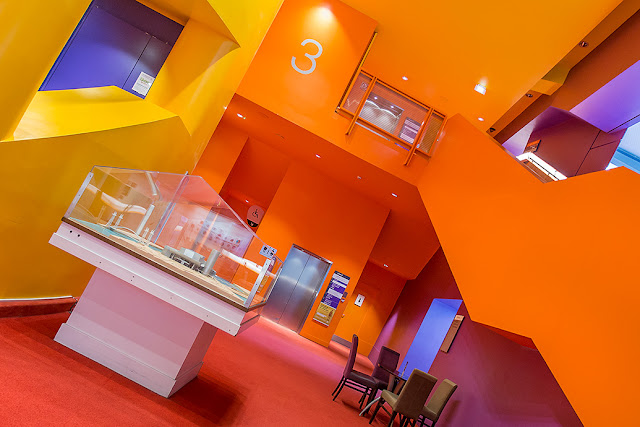
Visit www.novelenergylighting.com today to explore LED options for your project retrofit. We can supply Dextra, Philips, Thorn, and other major lighting brands, and support with site surveys and lighting designs. We can assist with project funding using energy efficiency financing. Call us: 0208-540-8287, or email us: sales@novelenergylighting.com today to start the discussion!
dextra led · LED downlights · led floods · led lighting · LED spots · led wall wash · lighting retrofits · museum lighting · Novel Energy Lighting · theatre lighting
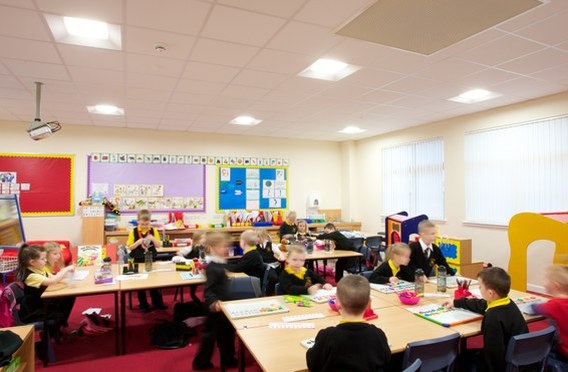
Education is no longer about teaching; it is about creating a stimulating learning environment. Or to put it another way the quantity of information given out by a teacher is less important than the amount of information taken in by a student. This shift in emphasis has impacted the design of education buildings. Previously they were designed around the needs of the teacher whereas they are increasingly designed around the needs of the student. This requires more flexible spaces suitable for formal teacher led sessions and also for less formal group discussions and breakout sessions.
Building design has also developed as the importance of daylight to learning rates and attendance levels has begun to be understood. Therefore modern learning spaces tend to receive significant levels of daylight which in turn leads to significant energy savings in well-designed lighting installations.
Best practice
The European Standard EN 12464-1:2011 Light and lighting – Lighting of work places Part 1: Indoor work places provides recommended lighting levels for academic buildings. However whilst important these recommendations address only a part of the lighting requirements. Education is a communication centred discipline and lighting of people so they appear friendly and so that body language is readily visible is important, as is facilitating the use of all presentation materials and formats. EN 12464-1:2011 also provides recommendations for cylindrical illuminance to ensure good lighting of verticals, 150lx at 1.2m height. It discusses the modelling index, the ratio between the horizontal and vertical flow of light, to provide the correct balance between light and shade. It also highlights the importance of lighting room surfaces to make a space feel light and airy and prevent a sensation of gloom, recommending an average illuminance of 75lx on the walls and 50lx on the ceiling.
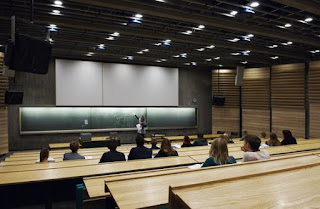
Education should always be centred on the needs of people and care should be taken not to design spaces for technology at the expense of comfort. However in some areas of high DSE use care should be taken to take account of the effect of lighting on screens. Recommendations for lighting for DSE are provided in the European Standard EN 12464-1:2011 Light and lighting – Lighting of work places Part 1: Indoor work places. However these criteria are for general computer technology and if plasma screen technology is used tighter control of luminaire brightness should be considered. Ideally the balance between lighting for people and lighting for technology should be achieved by intelligent use of lighting controls and scene setting to allow lighting to be adjusted to the needs of the moment.
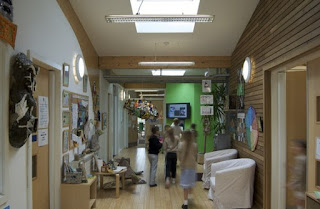
Taking control
Supplying comfortable and effective light is not the same as supplying controlled and energy-efficient light. A lighting system should interact with the space, dimming in response to increasing levels of daylight, turning on or off in response to occupancy within the space, and with increasing use of technology and the need for flexibility of learning styles allow lighting scenes to be set to provide the optimal conditions for the needs of the task at hand. Lighting should be an integral part of the space ambience, giving a calm or lively atmosphere dependant upon the needs of the subject, providing an inspiring and stimulating environment for students and staff.
Visit www.novelenergylighting.com to explore LED lighting retrofit options for your school or university project. Please call us to discuss options or arrange for light designs: tel. 0208-540-8287, email: sales@novelenergylighting.com
LED downlights · led lighting · led panels · led tubes · Novel Energy Lighting · school led · school lighting · university lighting
There are many easy ways facility managers can make fast and permanent changes to their lighting that will save on energy, slash maintenance and give quick paybacks. Swapping traditional technologies for LED is the easiest of all…
There must be things that the hard-pressed facilities manager can do to make their job just a little bit easier, and maybe save a bit of money for better things. Here’s a list of actions that shouldn’t take too much effort to work out and which should see immediate benefits.
Replace 2D lamps with LED modules
There’s no reason why utility bulkheads in service areas should still be fitted with 2D fluorescent lamps. There are plenty of efficient LED alternatives designed specifically to replace the 2D lamp. They’ll provide around 70% energy savings, with improved light output across a lamp life of around 50, 000 hours.
But be careful and do a bit of research. Switching from a fluorescent 2D lamp to an LED retrofit isn’t only an easy fix for you; it’s also an easy option for unscrupulous manufacturers and suppliers, so be sure of who you’re dealing with.
Eliminate all tungsten lamps
There may be a very special reason why THAT filament lamp needs to stay in THAT fixture in THAT room, but otherwise there really is no excuse to be holding onto any filament lamps.
Let’s remind ourselves of the facts: tungsten and tungsten halogen lamps operate at around 10 – 20 lm/W, compared with LED retro-fit lamps that start at 60lm/W and only get better. And some of those LED lamps can be dimmed, making the savings even greater.
The usual warning about LED product needs to be aired here. There are companies out there who just want to take your money and offer very little in return apart from problems. Make sure that you know who you’re dealing with when it comes to LED retro-fit lamps.
Swap out T12 fluorescent tubes
Extraordinarily, it’s still possible to buy T12 fluorescent lamps, because there are still companies making them. It’s like calling into a Ford dealership and being offered a Cortina. The only reason for still using a T12 fluorescent lamp is because no one’s got round to changing those 1800mm and 2400mm battens that were installed thirty years ago.
So, on the grounds that anything else is better than a T12 lamp (except a filament lamp) it’s time to replace the old fixtures with some modern technology. These days that will mean a one-for-one replacement with either an LED fixture or a T5 fluorescent equivalent, depending on which gives you the better performance for the task.
Install presence sensors in toilets
Lights being left on when rooms are vacant is just wasted energy. The simplest fix is to install a movement sensor on the ceiling, wired between the light switch at the door and the light fittings. Then all you need to do is to change the wall-switch to a secure key switch – and leave it in the ON position.
The sensor will detect when someone comes into the toilet and switch on the lights automatically. So far, so easy, but there is one issue that always needs to be taken care of – its no comedy when the lights go out and you’re tucked away in a cubicle. Good sensors are fitted with adjustable time-settings to avoid embarrassment.
Fit absence detectors where you can
If we accept the argument that lighting an empty room is a waste of energy, then we might shift our attention to an energy management structure that might bring savings from working spaces beyond the toilets.
The quick fix is to accept that every room needs to be taken on its merits and provide such energy saving technology as may be relevant. Don’t get hung-up on an estate-wide solution; do what you can and what makes sense.
The common situation is that a room is vacated and stays empty for a decent length of time, with the lighting left ON. Installing absence sensors into the lighting circuit ensures that an empty room automatically switches to an unlit room. Absence detectors switch the lighting off but do not switch the lighting back on when someone comes into the room; that decision is left with the occupants.
The only gripe about absence detectors is that they promote lazy thinking – see ‘education’ below.
Use daylight controls
Most of the time we’re thinking about saving energy from artificial lighting after dark, or in rooms where there is little or no natural light. But, where its available, natural light equals free illumination.
The easy catch is the area along windows where daylight ingress will exceed interior light levels for much of the day. What happens next depends on the state of the ceilings. If rooms are fitted with a suspended ceiling system then there is a readily available easy fix. Install daylight sensors along the window line and create two zones, one that is lit 100% by artificial lighting, while the other benefits from available daylight.
There are varying levels of sophistication around daylight controls, with some buildings controlled so that each run of light fittings (parallel to windows) has separate control. That may be a step too far, but there’s no need to walk away from the idea when a simplistic option is available.
Manage your exterior lighting
This calls for a bit of analysis but can give you a satisfying return on the effort. All external areas can be assessed by their usage and their security needs. A space that is in use at all hours and has serious security requirements will need lighting throughout the hours of darkness, and will probably be supported by a CCTV system. On the other hand, a back-of house loading area that is only ever in use during normal working hours and which is otherwise inaccessible may need nothing more than some low-level security lighting that can be triggered by sensors.
Working through the estate, zoned lighting installations can be retro-fitted with sensors and time-switches to guarantee energy savings, and probably make life for those in neighbouring properties a bit more comfortable.
Swap emergency bulkheads for self-test luminaires
The emergency lighting regulations require regular testing of the emergency lighting installation. In a large estate this has been compared to painting the Forth Bridge and it’s not surprising to hear that some installations receive only the minimum attention needed to stay on the right side of legal.
The easiest fix is simply to remove the old self-contained luminaires that are controlled via a key-switch by the door and replace them with luminaires that contain internal circuitry that enables the luminaire to monitor itself. Regular checks then only require a visual check of the LED display on each fitting, making life far easier for technical staff.
An important note, though. You’ll still have to carry out the annual real-time inspection. Getting free from that chore requires a far more complex solution.
Educate your occupants
The most cost-effective method of energy management is to have knowledgeable building users who understand the implications of lights being switched on and left on when it’s not necessary. The best type of sensor is the person with their finger on the light switch.
Of course, the potential hazard lurking behind any kind of well-intentioned behavioural training is that you end up alienating exactly those people you need to encourage. Teaching staff members to be more alert to energy management needs careful handling; but once the argument is won, the benefits are there for a long, long, time.
Oh, and clean your fittings!
Once all is said and done, and the installation is working well, with all the sensors fitted and staff members on-message there’s still one thing to get to grips with, and that is cleaning.
Most commercial and industrial light fixtures are technical constructions. They have reflectors and diffusers and these will need regular cleaning if the light levels aren’t to fall below acceptable standards. What ‘regular cleaning’ means in practice will be determined by local environment and health & safety factors. Clean Rooms are probably already being kept in an immaculate state, but back-of-house service areas are possibly running at less than the optimum level.
A good cleaning regime means that money is not being wasted by dust and grime stopping that expensive light getting out of the fixture.
Call us to discuss lighting for your premises: 0208-540-8287. Visit www.novelenergylighting.com to explore our range of LED downlights, LED tubes, LED panels, and sensors.
facility management · FM · led 2d · LED downlights · led lighting · led panels · led tubes · lighting · Novel Energy Lighting · occupancy sensors · PIR sensors
Modern offices are increasingly dominated by display screen technology. Whilst appreciable quantities of paper documents are still in use they are normally in association with computers, and this balance is gradually moving toward increasing display screen use and decreasing quantities of written or printed text. A side-effect of this is the reduction in the amount of filing requirements as documents are stored on a computer disk.
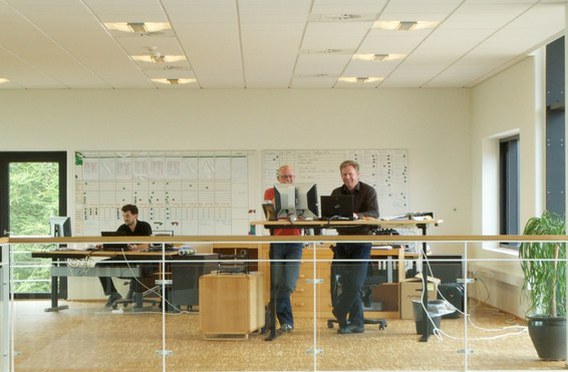
This has resulted in a change in office furnishings with fewer storage cabinets and an increase in technology, and also in a fundamental shift in task position, from predominantly horizontal documents to predominantly vertical display screens.
Additionally in many offices collaborative working is encouraged where formal or informal face-to-face discussions occur to consider short-term issues or long-term plans.
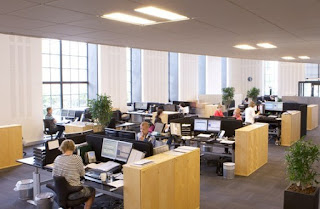
Building design has also developed as energy costs and sustainability issues gain importance, resulting in a high proportion of modern office space receiving significant levels of daylight.
Best practice
These changes impact all aspects of the design of modern office building services including artificial lighting. Lighting must be designed to prevent disturbing reflections on display screens, requiring a high level of optical control and technical competence in luminaire design. Lighting must also provide adequate illuminance to occupant’s faces, modelling features sympathetically and therefore allowing good visual as well as aural communication. This interplay of display screen versus human requirements needs careful planning of a lighting installation to produce a fulfilling space suitable for the task. Recommendations for lighting for DSE and also for modelling of faces and vertical surfaces are provided in the European Standard EN 12464-1:2011 Light and lighting – Lighting of work places Part 1: Indoor work places.
EN12464-1 provides recommended illuminance levels for a variety of office tasks. These illuminance values are task related and best practice is to layer the lighting levels, balancing the level on the task, the level on the surrounding area and the level on the background. It has been shown that the perception of how light or gloomy a space appears is based upon a 40° band in front of the viewer. This is generally the room walls and a portion of the ceiling. It is therefore important that room surfaces are lit to prevent a gloomy, oppressive ambience and EN 12464-1:2011 recommends an average illuminance of 75lx on the walls and 50lx on the ceiling.
Taking control
Supplying comfortable and effective light is not the same as supplying controlled and energy-efficient light. A lighting system should interact with the space, dimming in response to increasing levels of daylight, turning on or off in response to occupancy within the space, and with increasing use of technology, especially within meetings, allow lighting scenes to be set to provide the optimal conditions for the task at hand. Lighting should be an integral part of the office ambience, giving a calm or lively atmosphere dependant upon the needs of the task and space, providing a fulfilling workplace for people to enjoy and be stimulated in, benefiting both the individual and the business.
Call us today to discuss your office lighting needs, tel: 0208-540-8287, or email: sales@novelenergylighting.com. We supply a full range of LED panels, tubes, and downlights suited to office requirements. Visit us at www.novelenergylighting.com to explore our range of Thorn LED products.
led 1200x300 · led 1200x600 · led 600x600 · LED downlights · led panels · led tubes · Novel Energy Lighting · office led · office lighting · thorn led · thorn lighting

How can Megaman’s latest lighting solutions; including reflectors, modules and integrated fixtures enhance your retail application?
Attracting Customers
Lighting plays a crucial role in winning a customer’s attention, and designers are increasingly using it to enhance the shoppers experience, especially in high end retail shops.
Setting the Mood
Lighting affects customers mood and energy levels. It also provides guidance and orientation. The correct lighting creates a welcoming, comfortable and enjoyable environment, lengthening customers visits and influencing their buying habits.
Enhancing Product Appearance
A quality lighting system can make a big difference in retail settings by enhancing products visual appeal in terms of colour, shape and texture. Used correctly, lighting can provoke more interest in your product displays. For example; Megaman’s Perfect White technology enhances fluorescent whitening agents, making white products stand out from the crowd.
Creating a Desirable Instore Experience
Many luxury retail stores use a combination of ambient, accent and decorative lighting to create a positive shopping experience.
Visit www.novelenergylighting.com to explore the Megaman LED lighting range, or call us to discuss you retail lighting project. Tel: 0208-540-8287, email: sales@novelenergylighting.com
LED downlights · led GU10 · LED spots · Megaman LED · megaman lighting · Novel Energy Lighting · retail led · retail lighting · shop lighting
Older posts >>

















